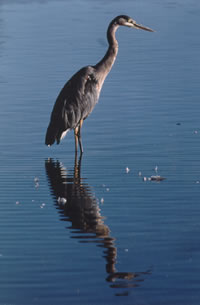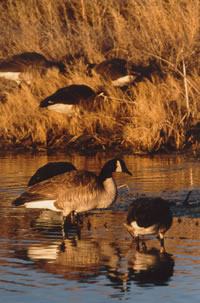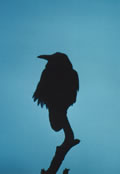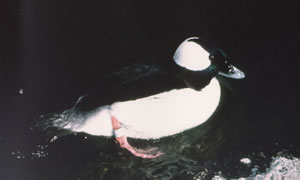 NATURE
HAPPENINGS - December 2002
NATURE
HAPPENINGS - December 2002
Flurries of Feathers -
Winter’s CBC
 During
one Saturday in the early portion of winter (between December 14th
and January 5th) a nation of bird watchers will participate in one
of the longest running data collection programs in the United States
- the Christmas Bird Count. Better known as the CBC, this year marks
the count’s 103rd anniversary. With more than 50,000 participants
in more than 1,800 counts, this is quite a large voluntary effort
by citizens to gain an understanding of winter avian distribution
and status of early winter populations.
During
one Saturday in the early portion of winter (between December 14th
and January 5th) a nation of bird watchers will participate in one
of the longest running data collection programs in the United States
- the Christmas Bird Count. Better known as the CBC, this year marks
the count’s 103rd anniversary. With more than 50,000 participants
in more than 1,800 counts, this is quite a large voluntary effort
by citizens to gain an understanding of winter avian distribution
and status of early winter populations.
Hatched during the turn-of-the-century, this count was a nonconsumptive
way to enjoy birds around the Christmas holidays. Replacing the
“Side Hunt,” a day-long excursion into the field whose
participants attempted to shoot more birds than their opposing side,
the Christmas Bird Count was organized by Frank Chapman of the then-fledgling
Audubon Society.
That first winter, 27 participants
counted birds in 25 different locations from Massachusetts to Monterey,
California. Together they counted some 90 different species; this
was long before Peterson Field Guides or National Geographic Guides
or CD recordings of bird calls. Bird watchers back then were probably
a suspect lot.
 Locally,
the Moab Bird Club, a loosely-knit flock of birders, organizes the
Moab Count. The 15-mile diameter count circle encompasses Spanish
and Castle Valley, the River Road, Matheson Preserve, Ken’s
Lake and a small portion of the Loop Road. In January of 2002, 47
birders and three teams of feeder-watchers, counted more than 12,000
birds made up of 74 species. Participants enjoyed a fine day in
the field and hosted a wrap-up brunch the following day.
Locally,
the Moab Bird Club, a loosely-knit flock of birders, organizes the
Moab Count. The 15-mile diameter count circle encompasses Spanish
and Castle Valley, the River Road, Matheson Preserve, Ken’s
Lake and a small portion of the Loop Road. In January of 2002, 47
birders and three teams of feeder-watchers, counted more than 12,000
birds made up of 74 species. Participants enjoyed a fine day in
the field and hosted a wrap-up brunch the following day.
Though I can’t say that I have taken part in Moab’s 18
or so winter counts, I have been associated with many of them. And
though a number of them were held on mild winter days that has not
always been the case. One winter in particular, we hiked through
six to ten inches of fresh snow, and braved freezing temperatures.
That fowl day (pun intended), I think the feeder watchers outnumbered
the field surveyors.
So what takes place during a CBC? From an initial organizational
meeting, teams are assigned to different portions of the count circle.
Maps and data sheets are distributed and tips on locations for certain
species are shared, as certain species favor select locations and
may be easily overlooked. The teams then cover their prospective
turf, walking, driving, or biking through neighborhoods, woodlands
and open areas in search of feathered beings. Species and their
numbers are recorded; unusual or unlikely species require some additional
notes for identification purposes. Pigeons count, but plastic flamingos
do not.
 Last
year, about a dozen volunteers searched for owls - one of the groups
of birds easily missed during the day surveys - by playing taped
calls of western screech owls in certain locations at night. A total
of four screech owls was found, far short of the 100 plus that the
Grand Junction group locates each winter. At least we know what
is our competition.
Last
year, about a dozen volunteers searched for owls - one of the groups
of birds easily missed during the day surveys - by playing taped
calls of western screech owls in certain locations at night. A total
of four screech owls was found, far short of the 100 plus that the
Grand Junction group locates each winter. At least we know what
is our competition.
The CBC is open to all interested individuals from novice birders
to professional ornithologists. The Moab group organizes participants
by ability and desire so that beginning birders may join a team
with more experienced individuals. The rewards are many, other than
lots of fresh air and cold weather. I still have vivid memories
of unusual sightings from past CBC’s - six soaring eagles above
Castle Rock, a snowbound Lincoln sparrow, a plummeting Cooper’s
hawk slicing through a flock of starlings and catching one. So for
this winter’s CBC I look forward to the forecast - under partially
sunny skies, flurries of feathers with a strong chance of an unusual
sighting, followed by darkness and owl hoots.

|
**Interested individuals may contact Andrea
Brand or Rick Boretti at 259-4050 for more information about
this winter’s Christmas Bird Count.
|